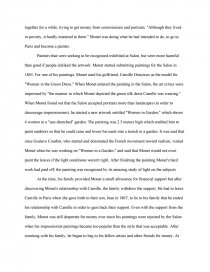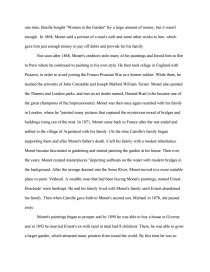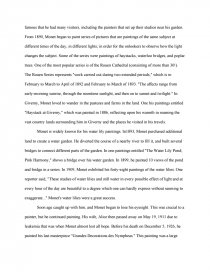Claude Monet Case
Essay by ejiang3648 • October 21, 2012 • Essay • 2,096 Words (9 Pages) • 2,233 Views
In the early 1870s, French painters' artworks were painted in a different style than what was acceptable at the time. These painters are called Impressionist painters; their style of painting is "characterized chiefly by concentration on the general impression produced by a scene or object and the use of unmixed primary colors and small strokes to simulate actual reflected light." Their intent was to show their subjects as they really existed or in or words, tried to be as realistic as possible. This was called the French Impressionism Movement, which was a major movement in painting and then later in music. The movement developed in France during the late 19th and early 20th centuries when a group of artists (whom shared the same techniques and approaches in art) rebelled against the strict standards in the art world of France. The principal Impressionist painters worked, influenced, and exhibited their own artworks and styles with each other. Among them was Claude Monet, who was regarded as an archetypal Impressionist due to his devotion to the ideals of the movement. Although Impressionism was very different than the art that preceded it, its style became popular years after. Now many exhibits today feature artworks from The Impressionists like Monet.
Claude Monet was born in Paris on November 14, 1840, his father was a grocer. In 1845 the family moved to the seaport city of Le Havre so that his father could go into business with his brother-in-law Jacques Lecadre, a grocer and ship chandler. As he recalled much later, "I am a Parisian of Paris. I was born there in 1840, under the reign of the good king Louis-Philippe which was an epoch centered on business interests and in which the Arts were regarded with real derision. As it was, my childhood was spent at the Havre where my father had settled in 1845 in order to better pursue his own business interests and as it happened, this childhood of mine, was essentially one of freedom. I was born undisciplineable. No one was ever able to make me stick to the rules, not even in my youngest days. It was at home that I learned most of what I do know. I equated my college life with that of a prison and I could never resolve to spend my time there, even for four hours a day when the sun was shining bright, the sea was so beautiful and it was so good to run along the cliff-tops in the fresh air or frolic in the sea." (This was one of Monet's passages in his autobiography in which Monet builds himself his legend.)
His youth was mainly spent in Le Havre where he first excelled as a caricaturist; his caricatures were shared in a space in a frame shop with landscapes and maritime scenes by another painter named Eugène Boudin, who was one of the first French landscape painters to paint in the open air. Monet did not share Boudin's point of view in his paintings, but it was Boudin's persistence which had paid off and had convinced Monet to take lessons from him. Boudin taught Monet a new, inspiring way of viewing things in not only painting, but also in the concept of art; soon Monet was derived from his firm predilection for painting out of doors.
In 1858, Monet exhibited his first painting called "View of Roulles," but Adolphe Monet (Claude Monet's father) wanted Monet to follow in his footsteps in the grocery business which Monet refused. He therefore left for Paris and enrolled in the Academie Suisse, an art studio where he met Camille Pissarro. After 2 years of military service in Algiers for adventure, he returned to Le Havre to recuperate from a serious fever. During the 6 months at home, Monet acquainted with a Dutch painter named Johnkind. The Dutch painter completed the training that Monet had already received from Boudin and to whom he said he owed "the definitive education of my eye." After recovering, his aunt was able to buy him out from returning to the army but returned to Paris to study with a traditional painter (under his aunt's condition to let him be a painter) in 1862, when he was 22 years old. It was in Gleyre's studio, where Monet met Renoir, Sisley, and Frederic Bazille whom became friends and "important influences on each other" whom became the creators of French Impressionism. At the time Renoir and Monet lived together for a while, trying to get money from commissions and portraits. "Although they lived in poverty, it hardly mattered to them." Monet was doing what he had intended to do, to go to Paris and become a painter.
Painters that were seeking to be recognized exhibited at Salon, but were more harmful than good if people disliked the artwork. Monet started submitting paintings for the Salon in 1865. For one of his paintings, Monet used his girlfriend, Camille Doncieux as the model for "Women in the Green Dress." When Monet entered the painting in the Salon, the art critics were impressed by "the manner in which Monet depicted the green silk dress Camille was wearing." When Monet found out that the Salon accepted portraits more than landscapes (in order to discourage impressionism), he started a new artwork entitled "Women in Garden," which shows 4 women in a "sun-drenched" garden. The painting was 2.5 meters high which enabled him to paint outdoors so that he could raise and lower his easel into a trench in a garden. It was said that once Gustave Courbet, who started and dominated the French movement toward realism, visited Monet when he was working on "Women in a Garden," and said that Monet would not even paint the leaves if the light conditions weren't right. After finishing the painting Monet's hard work had paid off; the painting was recognized by its amazing study of light on the subjects.
At the time, his family provided Monet a small allowance for financial support but after discovering Monet's relationship with Camille, the family withdrew the support. He had to leave Camille in Paris when she gave birth to their son, Jean in 1867, to lie to his family that he ended his relationship with Camille in order to gain back their support.
...
...





